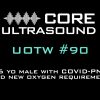A 72 year old female with a history of multiple sclerosis, incomplete paraplegia and atrial fibrillation presents from a skilled nursing facility to the emergency department complaining of abdominal pain, nausea, and vomiting. The patient’s records revealed multiple admissions for recurrent small bowel obstruction and gastrointestinal bleeding. The patient had experienced multiple episodes of nausea and vomiting throughout the past two days, but denied blood per rectum, and stated that her last bowel movement had been sometime the previous day.
Vital signs showed a HR of 112, BP 140/76, O2 sat 99% on RA, and a RR of 22. During physical examination breath sounds were normal bilaterally, abdominal distention was appreciated, as well as moderate abdominal pain on mild palpation. Due to multiple episodes of vomiting and high suspicion for a small bowel obstruction, a nasogastric tube was placed pending lab results.
The patient tolerated the procedure well, and the patient’s nurse confirmed placement of the NGT utilizing auscultation. The NGT was then placed, and a brown mucinous material was seen exiting the NGT. After roughly 15 minutes post NGT placement, the physician was notified the patient had begun to desaturate, and currently had an oxygen saturation of 82%. While speaking to the patient, she appeared mildly dysphasic, which was not noted previously. Due to patients baseline immobility, a pulmonary embolus was suspected. An CXR as well as an ultrasound were brought to the bedside to evaluate the heart and the following image was obtained:
A pulmonary ultrasound of the anterior lung fields was unremarkable. The transducer was then placed in the left lower lateral lung fields for the evaluation of a pleural effusion and the following image was obtained.
What do the clips show? What is the diagnosis? (Click the button for the answer!)

Desaturation due to pulmonary placement of nasogastric tube
The bedside echocardiography demonstrated atrial fibrillation and enlargement of bilateral atria without evidence of acute right heart strain. Attempted ultrasound of the left lower lung field showed a distended fluid-filled stomach, which was incompatible with a properly placed nasogastric tube. A stat CXR was ordered that confirmed the NGT to be in the left mainstem bronchus rather than the stomach. The patient had the NGT removed, and a short time later was noted to have her oxygen saturate improve and dysphasia resolved. The patient ultimately was diagnosed with a small bowel obstruction and was admitted for conservative management.
- While the placement of an NGT is considered to be a relatively benign procedure, it can lead to serious adverse outcomes. NGT’s inadvertently placed in the tracheobronchial tree can lead to a pneumothorax, hemothorax, pulmonary hemorrhage, pulmonary abscess, pneumonia, empyema, and even death 1,2 .
- Current bedside physical examination has been found to have inadequate sensitivity for confirming correct placement of NGT. The common method of auscultation has been shown as inconsistent in differentiation between pulmonary, gastric, or intestinal placement 3,4, and may be less accurate in a noisy environment such as the E.D.5
- Gurgling over the epigastrium has been observed to occur with secretions in the trachea 6.
- The absence of gastric content aspiration does not necessarily indicate proper placement, as there may be scant material in the stomach, or the end of the tube may not be directly in contact with gastric fluid 4
- Conversely, material extracted from the tracheobronchial tree may have the appearance of gastric fluid 1, while testing for pH can be inaccurate in patients taking gastric acid-blocking medication 7.
- While an XR is considered the gold standard, it may be associated with delay in the diagnosis 5, and in patients with multiple visits may be associated with harmful doses of radiation.
- NGT’s have been observed to pass into the bronchial tree without coughing, gagging or oxygen desaturation 3, and the patient described had a history of multiple sclerosis, which has been associated with swallowing difficulties such as absent or diminished gag reflexes 8.
Authors: Cody Russell
Peer Reviewer: Jacob Avila, MD
References
- Chenaitia H, Brun PM, Querellou E, et al. Ultrasound to confirm gastric tube placement in prehospital management. Resuscitation. 2012;83(4):447-451. doi:10.1016/j.resuscitation.2011.11.035
- Vigneau C, Baudel JL, Guidet B, Offenstadt G, Maury E. Sonography as an alternative to radiography for nasogastric feeding tube location. Intensive Care Med. 2005;31(11):1570-1572. doi:10.1007/s00134-005-2791-1
- Metheny N, Dettenmeier P, Hampton K, Wiersema L, Williams P. Detection of inadvertent respiratory placement of small-bore feeding tubes: a report of 10 cases. Heart Lung. 1990;19(6):631-638.
- Society of Pediatric Nurses (SPN) Clinical Practice Committee; SPN Research Committee, Longo MA. Best evidence: nasogastric tube placement verification. J Pediatr Nurs. 2011;26(4):373-376. doi:10.1016/j.pedn.2011.04.030
- Kim HM, So BH, Jeong WJ, Choi SM, Park KN. The effectiveness of ultrasonography in verifying the placement of a nasogastric tube in patients with low consciousness at an emergency center. Scand J Trauma Resusc Emerg Med. 2012;20:38. Published 2012 Jun 12. doi:10.1186/1757-7241-20-38
- Kerforne T, Chaillan M, Geraud L, Mimoz O. Ultrasound diagnosis of nasogastric tube misplacement into the trachea during bypass surgery. Br J Anaesth. 2013;111(6):1032-1033. doi:10.1093/bja/aet399 [PDF]
- Bourgault AM, Halm MA. Feeding tube placement in adults: safe verification method for blindly inserted tubes. Am J Crit Care. 2009;18(1):73-76. doi:10.4037/ajcc2009911 [PubMed]
- Poorjavad M, Derakhshandeh F, Etemadifar M, Soleymani B, Minagar A, Maghzi AH. Oropharyngeal dysphagia in multiple sclerosis. Mult Scler. 2010;16(3):362-365. doi:10.1177/1352458509358089



